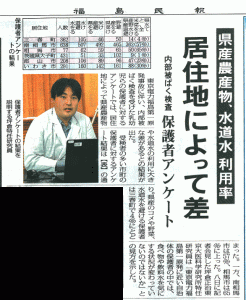Original Japanese written by staffer
The English below translated from the original Japanese by Heeday
The English translation edited by Rev. Dr. Henry French, ELCA
(Source: article of October 9th, 2015 edition of the Fukushima Minpo newspaper)
▼Click the image to enlarge it and read the caption.

This questionnaire survey, targeted at Fukushima parents with an infant/infants who were examined for internal exposure to radiation from TEPCO’s Fukushima Daiichi Nuclear Power Plant (NPP), found major differences in the rate those parent use both agricultural products produced within the prefecture and the local tap water.
Among those municipalities with a large number of parents who were examined for internal exposure, in Miharu-machi, only 4% of the respondents said that they avoided the use of rice and vegetables produced in Fukushima Prefecture, as well as local tap water. Meanwhile, in Minamisoma and Soma, the avoidance rate reached 57% and 65%, respectively. Mr. Masaharu Tsubokura, a special-mission researcher at the Institute of Medical Science, the University of Tokyo, described his opinion, saying, “Many of those parents living in the municipalities close to Fukushima Daiichi are still worried over their food and water.”
In Koriyama, another municipality in Fukushima, among the 208 parents that responded to the questionnaire, 106 (51%) said they avoided the use of tap water, 89 (43%) said they avoided rice produced in Fukushima, 96 (46%) said they avoided vegetables produced in the prefecture, and 47 (23%) replied that they avoided all of rice and vegetables produced in Fukushima as well as local tap water.
I (the author) live in Koriyama, where local grocery stores sell vegetables produced in Fukushima at lower prices than vegetables from elsewhere. Still, few buy Fukushima vegetables, many of which remain unsold.
A certain mother of a child, living in Koriyama, says she has never used fresh foods produced in Fukushima or local tap water for cooking or drinking since the NPP disaster.
For the last decade, I have heard that, in the contaminated forest around Chernobyl, many tree leaves have been turning into leaf soil, which is easily absorbed by plants. Today, in that forest, the highest level of radioactivity has been detected at 5 to 10cm (2” to 4”) below the soil’s surface. Furthermore, radioactivity inside wood from the forest has recently been rapidly on the rise, according to Mr. Masaharu Kawada, a molecular biologist involved in rescue work for Chernobyl refugees. In other words, the radioactivity of food and drink does not necessarily diminish as time goes by.
The Fukushima Daiichi meltdown drastically changed what it means to raise a child in Fukushima. Without sufficient, trustable information available on food safety, parents have been raising their children with serious stress and anxiety. Their fear of internal exposure to radiation, caused by contaminated food and drink, will never leave them. In addition to direct damage to health from internal radiation, the serious mental stress experienced by parents can adversely affect their children as well. For many years to come, those parents simply have to live with such fears and anxieties.
